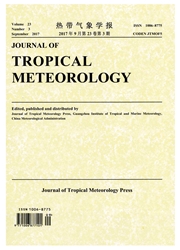

 中文摘要:
中文摘要:
这份报纸基于中国国家气候中心编的数据调查向西和平的副热带的高度(WPSH ) 紧张的 interannual 变化。从环境预言的国家中心和大气的研究(NCEP/NCAR ) 的国家中心的每月的分析数据也被用来学习在 WPSH 紧张和表面热流动异例之间的带落后关系。三主要调查结果如下:首先, WPSH 紧张介绍好季节的坚持,特别从冬季给随后的夏天。坚持在 1977 以后是更重要的,特别从春天,并且从夏天到夏天到秋天;逆旋风的异例的坚持比气旋的异例显著地好。第二,表面热流动在在 WPSH 紧张的强壮、弱的年之间的异常模式对面趋于到现在,它在在海洋上的潜伏的热流动是特别有效的。在在每季节的表面热流动和 WPSH 紧张之间的同时的关联由类似的关键区域被标记。最后,从强壮的夏天 WPSH 的前面的冬季的表面热流动在西北太平洋上相当类似于强壮的春天 WPSH,而是积极异例,日本的南方尤其是更强壮。弱年里的状况除了在西北太平洋上的那些是类似的:冬季表面热流动为弱夏天 WPSH 为弱春天 WPSH,而是积极异例显示出否定异例。在以前的冬季的表面热流动在在随后的春天和夏天维持 WPSH 紧张起一个重要作用,这被建议。
 英文摘要:
英文摘要:
This paper investigates the interannual variation of the West Pacific Subtropical High (WPSH) intensity based on the data compiled by the Chinese National Climate Center. Monthly reanalysis data from National Centers for Environmental Prediction and National Center for Atmospheric Research (NCEP/NCAR) are also used to study the lead-lag relationship between WPSH intensity and surface heat flux anomalies. The three major findings are as follows: First, WPSH intensity presents good seasonal persistence, especially from winter to the ensuing summer. Persistence is more significant after 1977, especially from spring to summer, and from summer to autumn; persistence of anticyclonic anomalies are significantly better than cyclonic anomalies. Second, surface heat flux tends to present opposite anomalous patterns between the strong and weak years of the WPSH intensity, which is especially valid at the latent heat flux over the ocean. Simultaneous correlations between surface heat flux and WPSH intensity in each of the seasons are marked by similar key areas. Finally, surface heat flux from the preceding winter of a strong summer WPSH is quite similar to strong spring WPSH, but the positive anomalies over the northwest Pacific and south of Japan are notably stronger. The situations in the weak years are similar except for those over the northwest Pacific: winter surface heat flux shows negative anomalies for a weak spring WPSH, but positive anomalies for a weak summer WPSH. It is suggested that surface heat flux in the previous winter plays an important role in maintaining the WPSH intensity in the ensuing spring and summer.
 同期刊论文项目
同期刊论文项目
 同项目期刊论文
同项目期刊论文
 Centennial variations of the global monsoon precipitation in the last millennium: Results from ECHO-
Centennial variations of the global monsoon precipitation in the last millennium: Results from ECHO- Inter-hemispheric comparison of climate change in the last millennium based on the ECHO-G simulation
Inter-hemispheric comparison of climate change in the last millennium based on the ECHO-G simulation THE RELATIONSHIP BETWEEN EXTREME PRECIPITATION ANOMALY IN SOUTH OF CHINA AND ATMOSPHERIC CIRCULATION
THE RELATIONSHIP BETWEEN EXTREME PRECIPITATION ANOMALY IN SOUTH OF CHINA AND ATMOSPHERIC CIRCULATION SEASONAL PERSISTENCE OF THE WEST PACIFIC SUBTROPICAL HIGH AND ITS RELATIONSHIP WITH THE SURFACE HEAT
SEASONAL PERSISTENCE OF THE WEST PACIFIC SUBTROPICAL HIGH AND ITS RELATIONSHIP WITH THE SURFACE HEAT The relationship of Land-Ocean thermal anomaly difference with Mei-yu and South China Sea summer mon
The relationship of Land-Ocean thermal anomaly difference with Mei-yu and South China Sea summer mon Impacts of land surface and sea surface temperatures on the onset data of the South China Sea summer
Impacts of land surface and sea surface temperatures on the onset data of the South China Sea summer The vertical structures of atmospheric temperature anomalies associated with El Nio simulated by the
The vertical structures of atmospheric temperature anomalies associated with El Nio simulated by the Simulation of the East Asian Summer Monsoon during the Last Millennium with the MPI Earth System Mod
Simulation of the East Asian Summer Monsoon during the Last Millennium with the MPI Earth System Mod Sensitivity of a regional ocean-atmosphere coupled model to convection parameterization over western
Sensitivity of a regional ocean-atmosphere coupled model to convection parameterization over western Two modes of the Silk Road pattern and their inter-annual variability simulated by LASG/IAP SAMIL2.0
Two modes of the Silk Road pattern and their inter-annual variability simulated by LASG/IAP SAMIL2.0 Variation of surface temperature during the last millennium in a simulation with the FGOALS_gl clima
Variation of surface temperature during the last millennium in a simulation with the FGOALS_gl clima Near Future (2016-2040) summer precipitation changes over China under RCP8.5 emission scenario proje
Near Future (2016-2040) summer precipitation changes over China under RCP8.5 emission scenario proje Two interannual variability modes of the Northwestern Pacific Subtropical Anticyclone in boreal summ
Two interannual variability modes of the Northwestern Pacific Subtropical Anticyclone in boreal summ Intensified eastward and northward propagation of tropical intraseasonal oscillation over equatorial
Intensified eastward and northward propagation of tropical intraseasonal oscillation over equatorial Historical Evolutions of Global and Regional Surface Air Temperature Simulated by FGOALS-s2 and FGOA
Historical Evolutions of Global and Regional Surface Air Temperature Simulated by FGOALS-s2 and FGOA El Nino-Southern Oscillation-related principal interannual variability modes of early and late summe
El Nino-Southern Oscillation-related principal interannual variability modes of early and late summe A comparison of the Medieval Warm Period, Little Ice Age and 20th century warming simulated by the F
A comparison of the Medieval Warm Period, Little Ice Age and 20th century warming simulated by the F Forced response of atmospheric oscillations during the last millennium simulated by a climate system
Forced response of atmospheric oscillations during the last millennium simulated by a climate system Simulated analysis of summer climate on centennial time scale in eastern China during the last mille
Simulated analysis of summer climate on centennial time scale in eastern China during the last mille Another Look at Interannual-to-Interdecadal Variations of the East Asian Winter Monsoon: The Norther
Another Look at Interannual-to-Interdecadal Variations of the East Asian Winter Monsoon: The Norther Forced response of the East Asian summer rainfall over the past millennium: results from a coupled m
Forced response of the East Asian summer rainfall over the past millennium: results from a coupled m Interdecadal variations of the western Pacific subtropical high and surface heat flux over East Asia
Interdecadal variations of the western Pacific subtropical high and surface heat flux over East Asia 期刊信息
期刊信息
